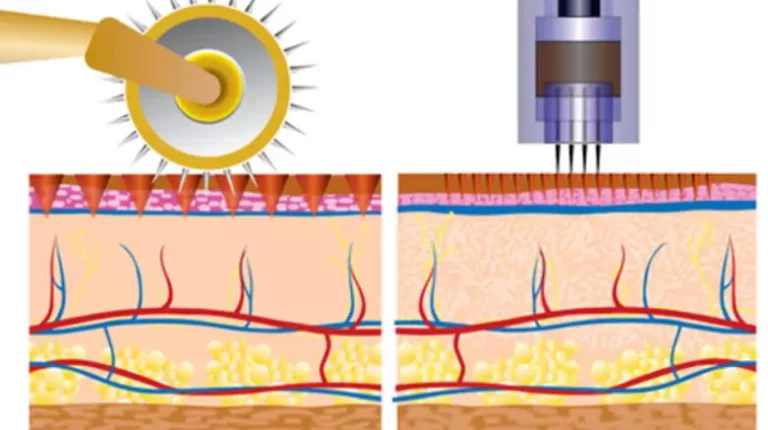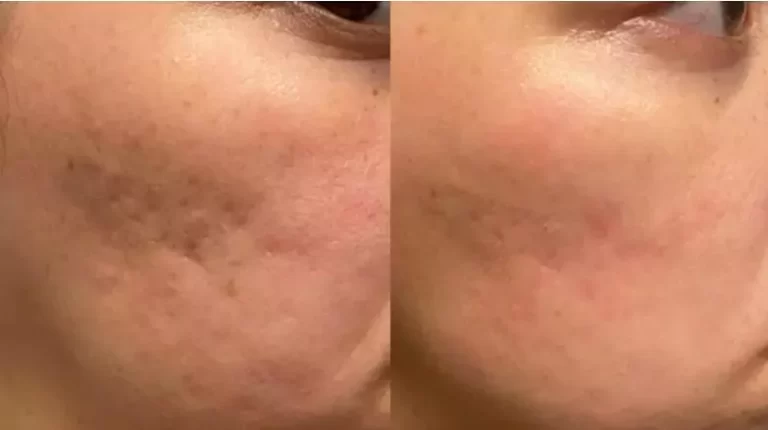Table of Contents
ToggleRisks of A Counterfeit Derma Roller: Skin Damage & Infections
Using a counterfeit derma roller can pose significant risks to your skin health. These hazards encompass premature dullness of needles, needles breaking off and becoming embedded in the skin, uneven microchannels resulting in scarring and infection, skin irritation, allergic reactions, and bacterial and fungal infections.
Improper sterilization of a counterfeit derma roller can result in microbial infections, granulomas, scarring, and hyperpigmentation. Allergic reactions and skin sensitivity issues may arise from a counterfeit derma roller due to unknown metal alloys, non-hypoallergenic coatings, and the presence of allergens such as latex. Poor-quality needles in a counterfeit derma roller can provoke adverse skin reactions, breakage leading to micro-tears in the skin, and dermal infections due to inadequate sterilization. Inconsistencies in needle length and penetration from a counterfeit derma roller can lead to uneven skin penetration, dull needles causing irritation and infection, and bent or broken needles resulting in scarring.

Risks of Using Counterfeit Derma Rollers
As a seasoned expert in dermatological equipment and skincare, I’ve encountered numerous cases where individuals have experienced adverse effects following the use of counterfeit derma rollers. These fake derma rollers, often manufactured without adherence to industry standards, pose significant risks to consumers. The primary issues arise from the lack of regulatory compliance in materials used, the manufacturing process, and sterilization methods, which can lead to a plethora of skin problems.
The utilization of substandard materials in these counterfeit devices can result in premature dulling of needles, causing more harm than benefit to the skin. Poor manufacturing of fake derma rollers may also lead to needles breaking off and becoming embedded in the skin, a situation that necessitates medical intervention. Furthermore, the inconsistency in needle length and density can create uneven microchannels, which not only affect the treatment outcome but also increase the risk of scarring and infection.
| Risk Factor | Description | Potential Effects |
|---|---|---|
| Material Quality | Poor quality metals or plastics | Skin irritation, allergic reactions |
| Needle Integrity | Blunt or breaking needles | Scarring, pain, potential need for medical removal |
| Sterilization | Inadequate or absent sterilization processes | Bacterial infections, transmission of pathogens |
| Needle Consistency | Variable needle lengths and densities | Uneven skin treatment, increased risk of infection |
Moreover, counterfeit derma rollers may not undergo proper sterilization techniques, which are essential steps to ensure the safety and effectiveness of these devices. Without adequate sterilization, there is an increased risk of bacterial and fungal infections, which can lead to long-term skin issues or even systemic health issues. It is imperative for users to comprehend the risks associated with the use of counterfeit derma rollers to mitigate these potential dangers.
Potential Skin Damage from Ineffective Sterilization
When it comes to derma rolling, the importance of sterilization cannot be emphasized enough. Using a counterfeit derma roller, which may not have undergone rigorous sterilization processes, poses a significant risk to skin health. In the absence of proper sterilization, bacteria, viruses, and fungi can easily thrive on the needles of these rollers. Once these contaminated needles penetrate the skin, pathogens have a direct entry point into the body, potentially causing a variety of skin issues.
One of the primary concerns is the development of microbial infections, which can manifest as rashes, swelling, or more severe skin conditions. These infections can be particularly challenging to treat and may require medical intervention. Additionally, the inflammation resulting from an infection can lead to scarring or hyperpigmentation, which are often more difficult to resolve than the original skin issues that prompted the use of the derma roller.
Improperly sterilized needles can additionally induce granulomas, small areas of inflammation resulting from a cluster of immune cells. These are often a response to a foreign substance that the body perceives as a threat. In the case of derma rolling with inadequately sterilized equipment, the foreign substance could be anything from bacteria to remnants of manufacturing materials.
It’s important to note that the lack of effective sterilization can accelerate the dulling of needles on a counterfeit derma roller. Dull needles can cause uneven micro-injuries, resulting in increased discomfort and uneven healing, leading to inconsistent skin texture and suboptimal outcomes from the derma rolling treatment. To mitigate these risks, ensure that any derma roller used is from a reputable provider and has undergone thorough sterilization processes before use.
Allergic Reactions and Skin Sensitivity Issues
When using a derma roller, especially one that is counterfeit, individuals should be cautious of allergic reactions and skin sensitivity issues that may arise. The materials used in fake derma rollers are often of substandard quality and may contain allergens that can trigger adverse reactions in the skin. These reactions can range from mild redness and inflammation to severe dermatitis. Skin sensitivity issues are particularly concerning as they can lead to long-term skin problems if not addressed promptly.
Counterfeit derma rollers heighten the risk of an allergic reaction because of the unknown composition of the materials utilized. For example, the needles might feature a non-hypoallergenic coating, or the handle could include latex, a prevalent allergen. The absence of regulation and quality control in counterfeit production offers no assurance regarding material safety across different skin types.
The Threat of Infection from Poor Quality Needles
Using counterfeit or substandard derma rollers poses a significant risk of infection, primarily due to the poor quality of the needles. The needles might consist of substandard materials that lack biocompatibility, resulting in adverse skin reactions and potential breakage during usage. The breakage of needles can cause micro-tears in the skin, which not only disrupts the healing process but also serves as an entry point for bacteria.
Furthermore, fake derma rollers may not undergo the rigorous sterilization process that genuine ones do. Proper sterilization is crucial because these devices penetrate the skin, breaching its natural barrier against pathogens. Insufficiently sterilized derma rollers may introduce bacteria directly into the epidermis, elevating the risk of dermal infections. Such infections can be challenging to treat and may require medical intervention, especially if they spread or cause systemic problems.
Another issue with low-quality needles is that they may lack the sharpness of those found on genuine derma rollers. Dull needles can cause unnecessary discomfort, heightened redness, and inflammation, all of which compromise the skin’s integrity. This diminishes the treatment’s efficacy while also increasing the infection risk, as hindered skin healing heightens susceptibility to bacterial colonization.
Ensuring that the derma roller is sterile before each use is imperative to prevent infections. However, with counterfeit products, the integrity of the packaging and the sterility of the derma roller upon delivery are often questionable. Users should remain vigilant and take extra precautions if they suspect the authenticity of their derma roller to mitigate the risk of contamination.
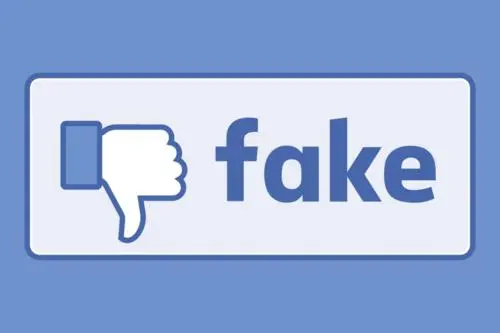
Inconsistencies in Needle Length and Penetration
When using a derma roller, the precision of needle length is crucial for achieving the desired skin treatment results. Authentic derma rollers are crafted with meticulous standards to ensure that each needle is of uniform length, providing consistent penetration and minimizing the risk of skin trauma. However, counterfeit derma rollers often display significant inconsistencies in needle length, which can lead to uneven skin penetration. This variability not only compromises the effectiveness of the treatment but also increases the likelihood of puncturing the skin too deeply, causing pain, bleeding, or bruising.
Furthermore, the quality of the needles themselves often falls short in counterfeit derma rollers. Manufacturers typically craft genuine needles from surgical-grade stainless steel or titanium, ensuring their sharpness and durability over multiple uses. In contrast, needles on fake rollers may lose their sharpness rapidly, bend, or even break, potentially causing micro-tears in the skin, which can lead to inflammation or infection. The table below outlines some of the potential hazards associated with needle irregularities:
| Risk Factor | Description | Potential Effects |
|---|---|---|
| Material Quality | Poor quality metals or plastics | Skin irritation, allergic reactions |
| Needle Integrity | Blunt or breaking needles | Scarring, pain, potential need for medical removal |
| Sterilization | Inadequate or absent sterilization processes | Bacterial infections, transmission of pathogens |
| Needle Consistency | Variable needle lengths and densities | Uneven skin treatment, increased risk of infection |
Customers must understand the critical importance of needle quality in derma rolling. Inconsistent needle penetration can not only impede the skin rejuvenation process but also pose a significant risk to the skin’s integrity. Without the controlled injury that derma rolling aims to induce, the skin’s healing response may be erratic, resulting in suboptimal outcomes or even adverse effects. Therefore, it is advisable to invest in a high-quality derma roller to ensure a safe and effective treatment.
The Long-Term Effects of Substandard Skin Treatments
The desire for achieving youthful, radiant skin through microneedling can often drive individuals to seek cost-effective solutions. However, using counterfeit or fake derma rollers can lead to a plethora of long-term skin issues. Unlike professional-grade equipment, these inferior products may not adhere to stringent manufacturing and quality control standards, potentially resulting in uneven needle sizes and poor material quality. Over time, the repeated use of such devices can cause chronic skin trauma.
One of the more insidious risks lies in the potential for scar tissue formation. Repetitive skin injuries caused by inconsistent needle penetration can disrupt the natural healing process, resulting in the accumulation of fibrous tissue. This can result in a rough, uneven skin texture, which is contrary to the smooth, refined complexion that microneedling aims to promote.
Furthermore, substandard derma rollers may introduce harmful substances into the skin due to the degradation of needle coatings or the use of unsafe materials. These substances can accumulate in the skin layers, potentially causing long-term dermatological conditions, including chronic inflammation or allergic reactions that may become challenging to treat.
It is also essential to consider the psychological impact of using fake derma rollers. The frustration and distress caused by deteriorating skin conditions can be profound, affecting an individual’s self-esteem and confidence. The psychological stress, in turn, can exacerbate skin problems, leading to a vicious cycle of skin damage and emotional distress.
In summary, while the immediate results of using subpar derma rollers may seem negligible, the long-term consequences can be severe, both physically and psychologically. It’s crucial to prioritize skin health by choosing genuine, high-quality microneedling tools that ensure safe and effective treatment, thereby preserving the skin’s integrity and appearance over time.
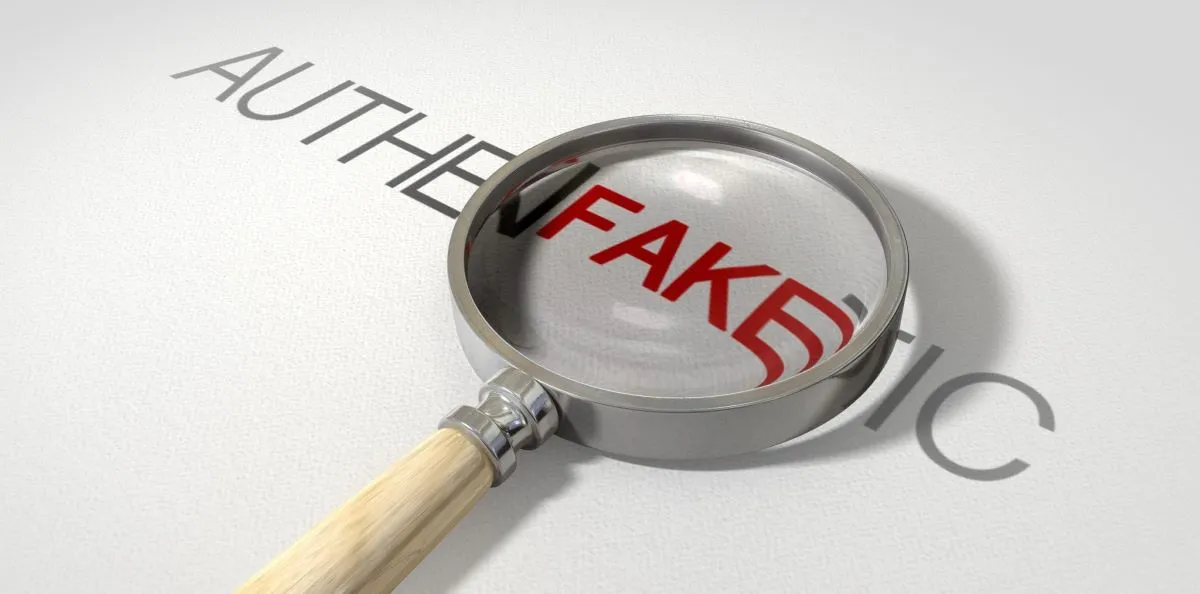
Identifying Authentic Derma Rollers: Tips and Tricks
Choosing Authentic Derma Rollers: Packaging and Branding
In the pursuit of enhancing skin health and resilience, it’s crucial to distinguish between authentic and counterfeit derma rollers. Using a counterfeit derma roller can lead to a multitude of skin problems, emphasizing the importance of identifying genuine products. Here are some tips and tricks to ensure that you are purchasing an authentic derma roller:
Firstly, scrutinize the packaging and branding. Genuine derma rollers typically come with sleek, professional packaging featuring a recognizable brand logo. Look out for any spelling errors or inconsistencies that might indicate a counterfeit product. Moreover, authentic products usually include detailed instructions for use and safety information.
Authenticity Check: Needle Quality and Authorized Suppliers
Another essential step is to verify the quality of the needles. Authentic derma rollers are crafted with high-grade, surgical stainless steel or titanium needles. These materials are chosen for their durability and hypoallergenic properties. In contrast, counterfeit rollers may utilize inferior metals that can bend, rust, or cause allergic reactions.
It’s also advisable to purchase from authorized suppliers or directly from the derma roller manufacturers. Many brands have authorized dealers or official websites where you can purchase their products. Be cautious of third-party sellers on online marketplaces, as these platforms can be rife with counterfeit items.
| Feature | Authentic Derma Rollers | Counterfeit Derma Rollers |
|---|---|---|
| Packaging | Expert with brand emblem | Frequently poor quality with mistakes |
| Needle Material | Surgical stainless steel or titanium | Inferior metals that can rust |
| Dealer | Authorized dealers or reputable websites | Unverified third-party sellers |
| Price | Reflects quality, often higher | Suspiciously low or discounted |
Finally, consider the price point. While everyone loves a good deal, an authentic derma roller is a precision tool that reflects its quality in its price. If the price seems too good to be true, it probably is. Counterfeit rollers are often sold at a significantly lower price to lure unsuspecting buyers.
By exercising due diligence and following these tips, you can protect your skin’s health by ensuring that you use only genuine derma rollers. Remember, the effectiveness of derma rolling is not just about the process itself but also the tools you use.
How to Safely Purchase Derma Rollers Online
Safe Online Purchase: Research and Verification
When considering the purchase of a derma roller online, exercising caution is paramount to ensure both the efficacy and safety of the skin treatment process. The market is inundated with counterfeit products that can pose significant risks to your skin’s health. To protect against these dangers, it’s crucial to conduct thorough research on the seller and the product. Begin by verifying the credibility of the retailer or online marketplace. Look for established companies with a strong online presence and positive customer reviews.
Examine the product descriptions carefully. Authentic derma rollers should have detailed information about needle length, materials, and sterilization techniques. Be wary of vague descriptions or overly broad claims that seem too good to be true. Additionally, genuine products often come with clear usage instructions and safety guidelines. Check for the presence of these documents as part of your assessment.
Genuine Derma Roller Checklist: Packaging, Pricing, and Policies
Another critical step is to scrutinize the product’s packaging and branding. Manufacturers of legitimate derma rollers invest in quality packaging with proper labeling, including batch numbers and expiry dates. This not only ensures product freshness but also indicates a traceable supply chain. If the product lacks these details, it may be a sign that it is not genuine.
Price can also be an indicator of authenticity. While everyone loves a bargain, an unusually low price may suggest that the product is counterfeit. High-quality derma rollers require precise manufacturing and premium materials, which are reflected in their price. If the price is significantly below market value, it is advisable to reconsider the purchase.
Finally, understand the return policy and warranty offered by the seller. A reputable retailer will typically offer a satisfaction guarantee or a warranty period, allowing you to return the product if it does not meet the expected standards. This not only protects your investment but also demonstrates the seller’s confidence in the product’s quality.
By adhering to these guidelines, you can reduce the risk of purchasing a fake derma roller and ensure that you are investing in a tool that is safe for your skin and effective in achieving your desired results. Remember, when it comes to skincare, the quality of the tools you use is just as important as the products you apply.
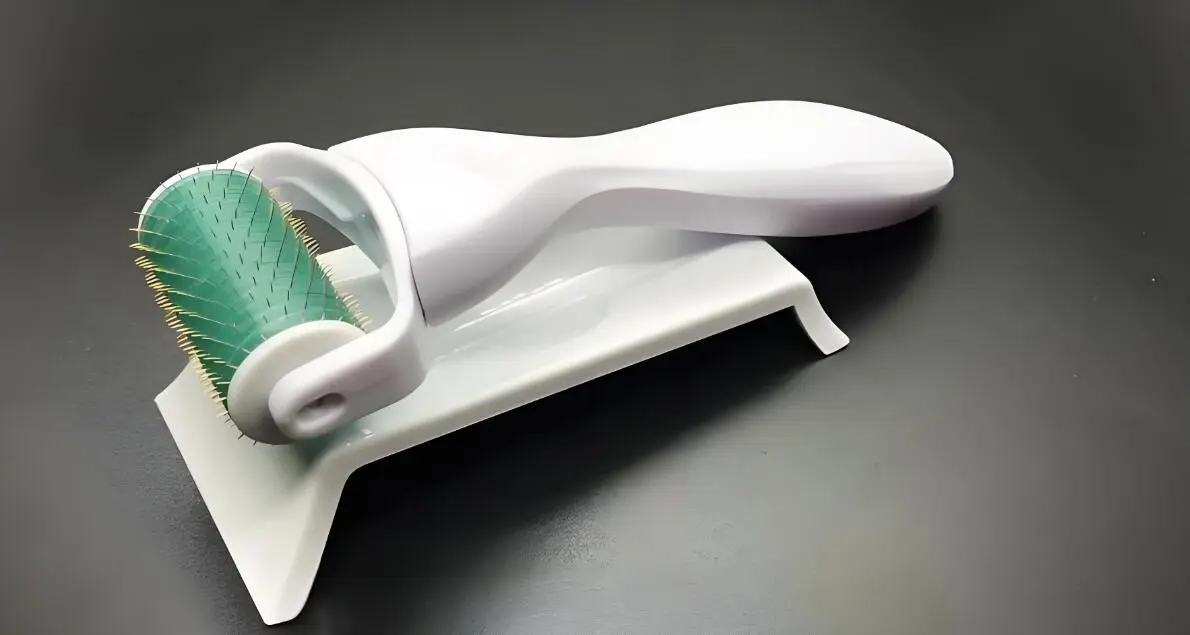
Professional Versus At-Home Derma Rolling: What You Need to Know
Professional vs. At-Home Derma Rolling: Safety and Quality
When considering derma rolling as a skincare routine, it’s crucial to understand the differences between professional treatments and at-home practices. Licensed dermatologists or skincare specialists conduct professional derma rolling, ensuring the procedure utilizes medical-grade equipment under sterile conditions. They employ derma rollers with needles of specific lengths, customized to address specific skin concerns, and are trained to minimize the risk of injury and infection.
At-home derma rolling, while more convenient and cost-effective, carries risks, especially when using counterfeit derma rollers. The quality of these fake tools is often subpar, with needles that may be blunt, uneven, or prone to rust, leading to skin trauma, inflammation, and potentially serious infections. Moreover, the lack of proper sterilization techniques can introduce bacteria and other pathogens to the skin.
Derma Rolling Needle Length Guide and Care Instructions
It’s essential to be well-informed about the needle sizes and their specific uses, as incorrect lengths can cause harm rather than rejuvenation. Below is a table outlining recommended needle lengths for various treatment purposes:
| Treatment Purpose | Recommended Needle Length |
|---|---|
| Skin Rejuvenation | 0.25mm – 0.5mm |
| Acne Scars | 1.0mm – 1.5mm |
| Stretch Marks | 1.5mm – 2.0mm |
| Hair Regrowth (scalp) | 1.5mm – 2.0mm |
| Cellulite Reduction | 1.5mm – 2.0mm |
Understanding these guidelines can help ensure that you use the appropriate needle length for your specific skincare needs, whether undergoing professional treatment or performing at-home derma rolling.
Individuals opting for at-home derma rolling should conduct thorough research to purchase authentic equipment from reputable providers. It’s advisable to seek guidance from a skincare professional before starting an at-home routine, to ensure the optimal technique is used and to avoid any adverse effects associated with fake derma rollers.
Proper care and maintenance of derma rollers are imperative to prevent complications. This includes regular sterilization before and after each use, storing the device in a clean, dry place, and replacing the roller head according to the manufacturer’s guidelines or if any signs of wear or damage are observed.
Proper Care and Maintenance of Derma Rollers to Ensure Safety
Effective Derma Roller Maintenance and Sanitation
The cornerstone of effective derma rolling is not just the procedure itself but also the rigorous care and maintenance of the device used. To mitigate the risks associated with the use of counterfeit derma rollers, it is paramount to adhere to stringent sanitation protocols. A genuine derma roller should be constructed with medical-grade materials and designed to withstand the sterilization process without degradation.
Before and after each use, thoroughly sanitize the derma roller by submerging the roller head in a solution of isopropyl alcohol for a duration recommended by the manufacturer, typically around five to ten minutes. Ensure the needles are fully immersed. After sanitization, place the roller on a clean surface to air-dry.
Storage of the derma roller is equally important. The device should be kept in a protective case to prevent accidental damage to the needles and to maintain hygiene. Exposure to dust and other contaminants can compromise the roller’s sterility, making proper storage a necessity.
Derma Roller Care and Maintenance Guide
Regular inspection of the derma roller is recommended to check for signs of wear and tear. Bent or dull needles can cause ineffective skin damage and should be a signal to replace the roller. As a general guideline, a derma roller should be replaced every 3-6 months, depending on the frequency of use and the quality of the roller.
For those who prefer visual cues, below is a table summarizing the key steps in the care and maintenance of a derma roller:
| Step | Description | Frequency |
|---|---|---|
| Sanitization | Submerge roller head in isopropyl alcohol for 5-10 mins | Before and after each use |
| Air-Drying | Place sanitized roller on a clean surface to air-dry | After sanitization |
| Storage | Store roller in a protective case to prevent damage | After drying |
| Inspection | Regularly check for signs of wear and tear | Regularly |
| Replacement Schedule | Replace derma roller every 3-6 months | Every 3-6 months |
By following these suggestions, users can ensure that their skin treatments are not only effective but also safe. It’s important to recognize that using a counterfeit derma roller can lead to serious complications, and therefore, investing in an authorized, high-quality product is of utmost importance for the health of your skin.

Why We Don’t Recommend To Use Counterfeit Derma Rollers
What are the risks of using a counterfeit derma roller?
Using a counterfeit derma roller can pose significant risks to your skin health. These risks include:
- Premature blunting of needles
- Needles breaking off and embedding in the skin
- Uneven microchannels leading to scarring and infection
- Skin irritation and allergic reactions
- Bacterial and fungal infections
What are the potential consequences of ineffective sterilization from a counterfeit derma roller?
Improper sterilization from a counterfeit derma roller can lead to:
- Microbial infections
- Granulomas
- Scarring and hyperpigmentation
How can allergic reactions and skin sensitivity issues be triggered by a fake derma roller?
Allergic reactions and skin sensitivity issues can arise from a counterfeit derma roller due to:
- Unknown metal alloys
- Non-hypoallergenic coatings
- Presence of allergens like latex
What are the threats of infection from poor quality needles in a counterfeit derma roller?
Poor quality needles in a counterfeit derma roller can lead to:
- Adverse skin reactions
- Breakage causing micro-tears in the skin
- Dermal infections due to lack of sterilization
How do inconsistencies in needle length and penetration affect skin treatment?
Inconsistencies in needle length and penetration from a fake derma roller can result in:
- Uneven skin penetration
- Dull needles causing irritation and infection
- Bent or broken needles leading to scarring
Reference:
- From Reddit, Is my derma roller real or fake?
- From YouTube, REAL vs FAKE DERMAROLLERS
- From TikTok, Fake derma rollers are typically of lower quality
- From Immigration and Customs Enforcement, Counterfeit Goods: A Danger to Public Safety
- From International AntiCounterfeiting Coalition, What is Counterfeiting?


